John Quincy Adams was in Ghent, New Netherlands (present-day Belgium) on Christmas Eve, 1814. He was the leader of the United States delegation, negotiating an end to America’s second war with Great Britain. On that December 24th, Adams and James, Lord Gambier, head of the British delegation, having finally agreed on the terms, signed the draft of the “Treaty of Peace and Amity between His Britannic Majesty and the United States of America“, bringing to an end the conflict that came to be known (in America) as the War of 1812.
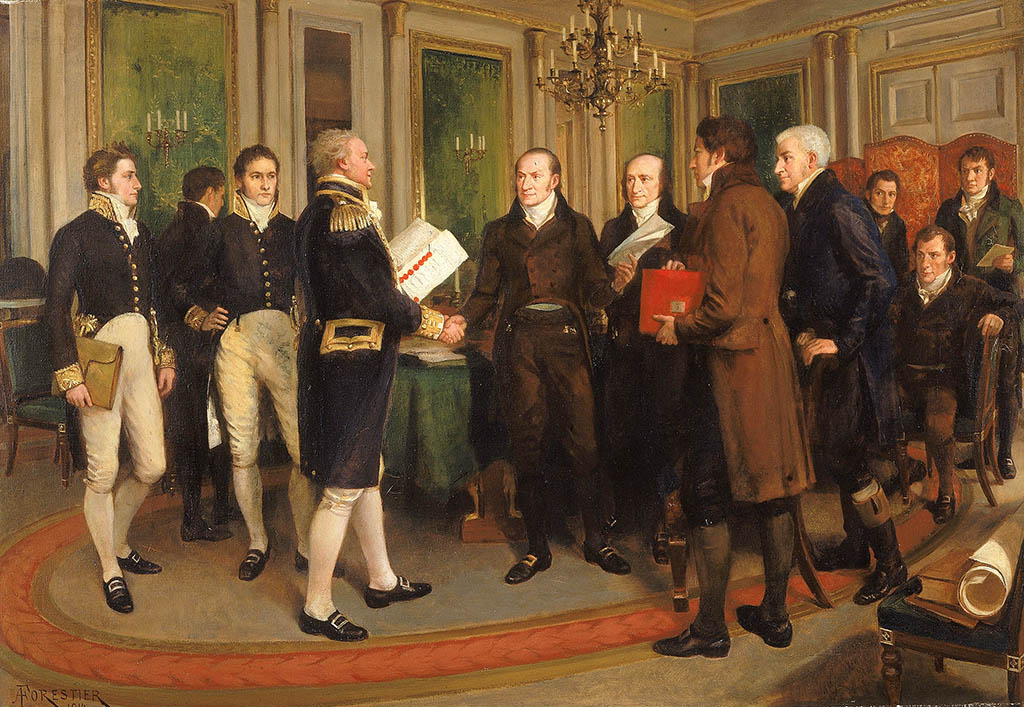
Boldly stated in Article the First of the Treaty was an anticipated hope:
“There shall be a firm and universal Peace between His Britannic Majesty and the United States, and between their respective Countries, Territories, Cities, Towns, and People of every degree without exception of places or persons.” [Treaty of Peace and Amity between His Britannic Majesty and the United States of America]
Later that evening, Adams wrote home to his mother, Abigail, in Massachusetts, and announced the news:
“A Treaty of Peace between the United States and Great Britain has this day been signed by the British and American Plenipotentiaries at this place.”
Adams concluded his letter with this caution:
“Of the Peace which we have at length concluded, it is for our Government, our Country and the world to judge. It is not such as under more propitious circumstances might have been expected, and to be fairly estimated must be compared not with our desires, but with what the situation of the parties and of the world at and during the negotiation made attainable. We have abandoned no essential right, and if we have left everything open for future controversy, we have at least secured to our country the power, at her own option to extinguish the War.” [John Quincy Adams to Abigail Adams, 24 December 1814, Massachusetts Historical Society Collections]
Less than 50 years later, the “firm and universal peace” hoped for in the Treaty of Ghent was strained with the advent of the American Civil War. Officially, Great Britain was neutral in the war between the Northern (Union) and Southern (Confederate) United States. As the conflict continued, however, British textile mills felt the imposition of the blockade on cotton exported from southern American ports. Some in England even supported the Confederate cause.
President Abraham Lincoln drafted the preliminary Emancipation Proclamation in September, 1862, and issued the official proclamation on January 1, 1863, thereby freeing all enslaved men, women, and children in the Confederate States. Great Britain had abolished slavery throughout the British Empire in July, 1833. The American Emancipation Proclamation caused Manchester, England mill workers to come out in support of democracy and the U.S. abolition of slavery, even though their textile trade depended upon American cotton.
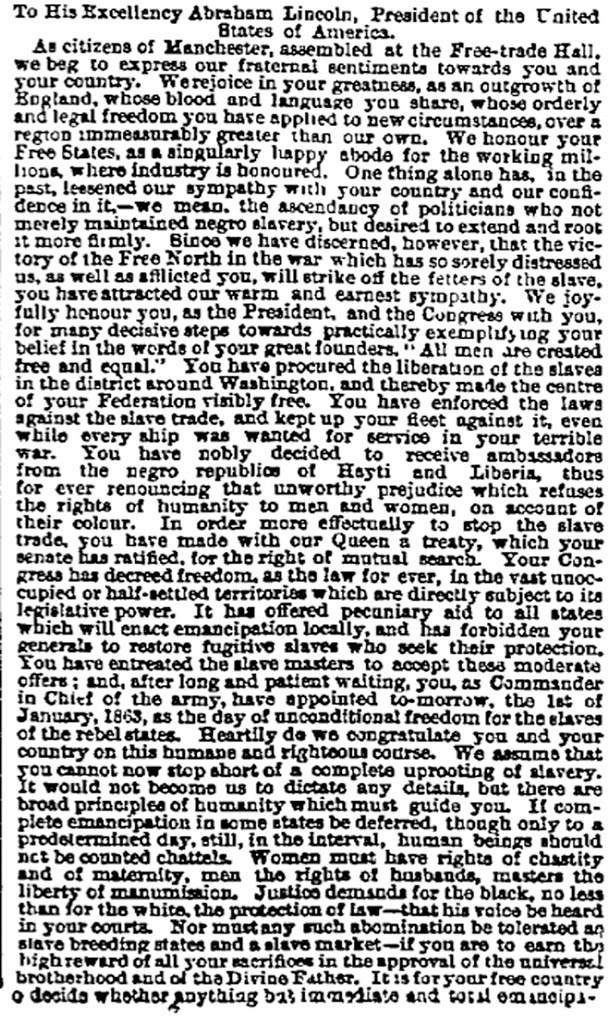
President Lincoln responded to the Manchester mill workers, calling their vote to stand with the anti-slavery movement “as an instance of sublime Christian heroism which has not been surpassed in any age or in any country…” He went on that “whatever misfortune may befall your country or my own, the peace and friendship which now exists between the two nations will be, as it shall be my desire to make them, perpetual”. [As quoted in “Britain and the American Civil War,” online exhibition of the British Library.]
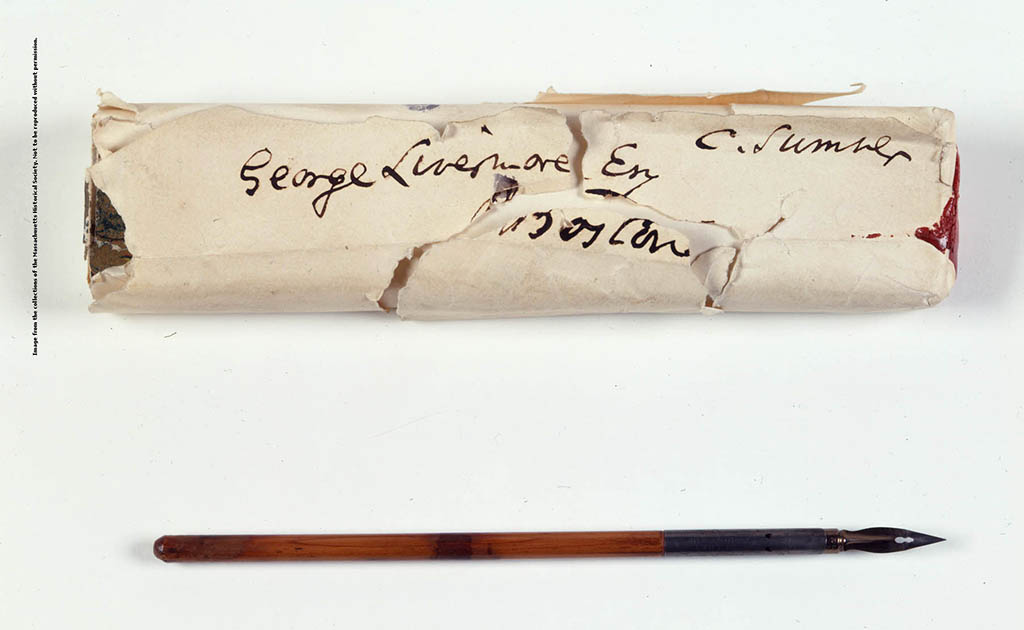
Commemorating the Century of Peace after the Treaty of Ghent
Despite the strain on Lincoln’s “peace and friendship” between the U.S. and Great Britain during the American Civil War, the relationship between the two countries would grow stronger into the 20th century. One hundred years after the signing at Ghent, the United States and Great Britain would commemorate the anniversary of the 1814 “Treaty of Peace and Amity” in myriad ways.
As early as 1911, Sulgrave Manor, ancestral home of George Washington’s family, was purchased at the initiative of the Peace Centenary Committees, as a way to commemorate the up-coming 100 years of peace after the close of the War of 1812. Sulgrave Manor, according to its website, “exists to promote friendship and goodwill between the British and American peoples…”
At Put-in-Bay, on South Bass Island, Ohio, a 352-foot, massive Doric column was built between 1912 and 1915, to mark peace between the United States and Great Britain and the United States and Canada.

Known as the “Perry’s Victory and International Peace Memorial,” the monument also commemorates the Rush-Bagot Pact of 1817, which eliminated U.S. and Royal Navy fleets from the Great Lakes, with the exception of small patrol vessels. As a plaque in the International Peace Memorial claims:
“A CENTURY OF PEACE SECURED BY SIMPLE DISARMAMENT
Proclaimed by President [James] Monroe, April 28, 1818, and still in full force, the Rush-Bagot Agreement is the most enduring and fateful result of the War of 1812….[it has maintained] in perfect peace for more than a century three thousand miles of frontier between the United States and the British Empire without soldier or ship, without fortress or gun…”
The Convention of 1818, one year after the Rush-Bagot Pact, set the international boundary between the U.S. and Canada at the 49th parallel. Both the Pact of 1817 and the Convention of 1818, reflected the easing of tensions between the U.S. and Great Britain.
The 1912 International Peace Memorial includes the remains of three U.S. Navy officers and three Royal Navy officers from the September 10, 1813, Battle of Lake Erie. These six officers were buried in the memorial’s crypt as a tangible reminder of the horrible cost of the War of 1812, while also noting the ensuing century of peace.

In 1913, the “American Committee to celebrate the One Hundredth Anniversary of Peace among English Speaking Peoples 1814-1914,” was organized by John A. Stewart. He had suggested the idea to President Theodore Roosevelt, author of The Naval War of 1812, several years earlier. Roosevelt was in support and became one of the honorary members of the Committee. The American Committee set for itself:
“…the Project to Celebrate the Centenary of the Signing of the Treaty of Ghent, which established lasting peace between America and Great Britain; as well as the plan to signalize, in fitting manner, the peace which has existed between the United States, Great Britain and other nations.”
The foreword to the American Committee’s prospectus noted that the celebration would include:
“the century of peace between America and France, Germany, Norway, Sweden, Holland, and the other great nations of the world with which [the U.S.] have never engaged in war.”
Sadly, before the centenary of peace anniversary was concluded, the first shots of World War I were fired in August, 1914.
The Great War
If you had been a school child in England before 1914, and were studying “The Great War,” you would have been learning about the 22-year conflict (1793-1815) between Great Britain and France, later known as the Napoleonic War. At the dawn of the 20th century, however, the cataclysmic and terrifying modern war of 1914 to 1918, became the new “Great War” due to its vast death toll and devastation and destruction through much of Europe. Following the end of The Great War, and with the growing tensions in Europe from 1920 onwards, writers and historians began to term the 1914 war “The First World War.” After 1940, in the popular press the title of “World War I” came to dominate in the public mind as the mid-20th century conflict became known as “World War II.” [1]
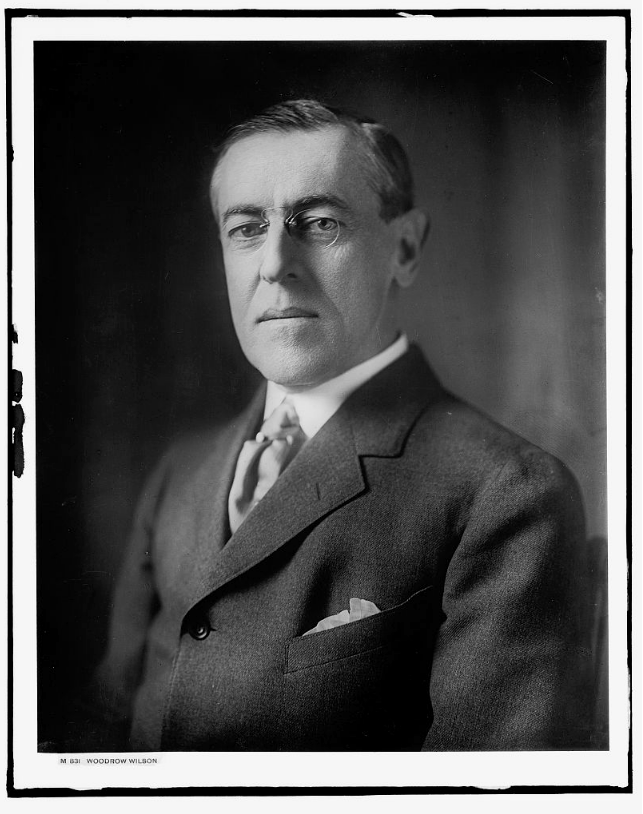
President Woodrow Wilson declared U.S. neutrality as The Great War grew in Europe, but attempting to trade with both Britain and Germany put a great strain on Anglo-American relations. Britain blockaded German ports, attempting to thwart that country’s designs by starving it of food and materiel needed to fight the war. Occasionally, the Royal Navy blockade captured U.S. merchant ships. Wilson argued that neutral ships carried neutral goods and that Great Britain was on shaky ground taking American merchant vessels. The U.S. was number three in naval power in the world at that time (behind Britain and Germany) and so could not force the issue, at sea, with Great Britain.
The loss of American ships, and/or ships with Americans on board, to German U-boats, however, caused greater outrage in the U.S. than the British blockade. After unrestricted U-boat warfare was resumed in January, 1917, Wilson revoked diplomatic relations with Germany. In February, the president learned of Germany’s attempt to recruit Mexico, with the promise of U.S. territory, through the British interception of the encrypted “Zimmerman Telegram“. U.S. public opinion, initially against joining the war, was turned as more American vessels were attacked and because of the implied threat of a German attack on the United States. Wilson had previously placed armed U.S. Navy personnel on civilian vessels as protection which, technically, constituted an act of war on Germany. All of these reasons contributed to Wilson’s request of the U.S. Congress for a declaration of war against Germany, which occurred on April 6, 1917.
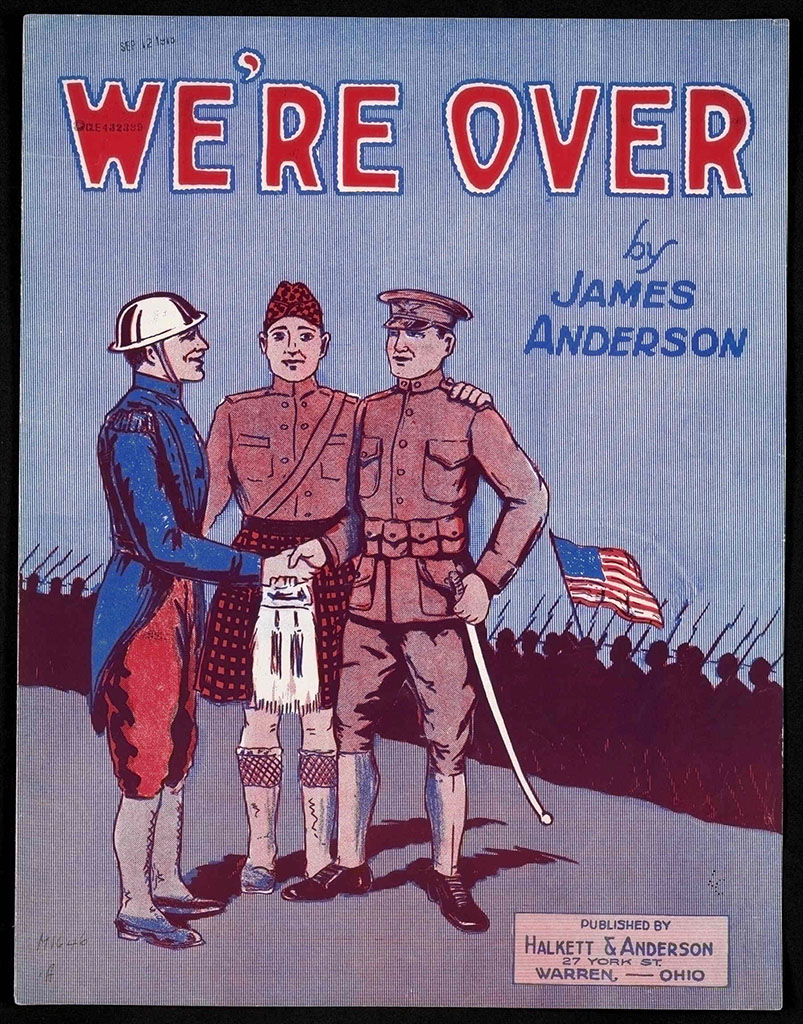
The Boston (Charlestown) Navy Yard, like all the other U.S. navy yards around the country, had been preparing for war in the months leading up to the declaration. And while USS Constitution, berthed in the Boston Navy Yard since 1897, played no actual part in World War I, her name was briefly appropriated for a new battlecruiser that, ultimately, was never finished.
Within days of the declaration, six U.S. Navy destroyers departed from Boston on April 24th. Commander Joseph Taussig, of Division Eight, Destroyer Force, Atlantic Fleet, steamed across the Atlantic with the instructions “to assist naval operations of the Entente Powers in every way possible.”
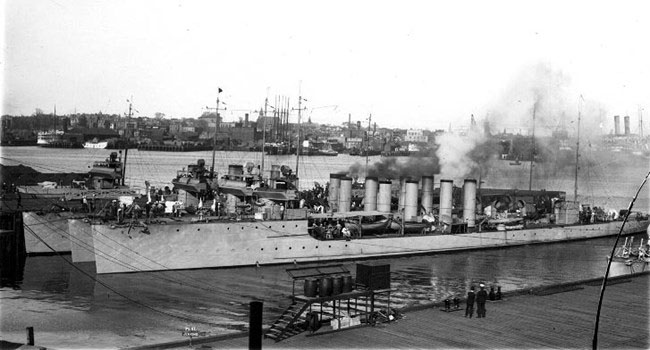
The six destroyers sailed to the Queenstown (now Cobh) naval base on the southern coast of Ireland, intending to combat and destroy the German U-boats that filled the waters of the Western Approaches to the British Isles. The arrival of this U.S. Navy fleet was afterwards called “The Return of the Mayflower“, reflecting the United States’ significant support and contributions to the Allies and the victory over Germany in The Great War.
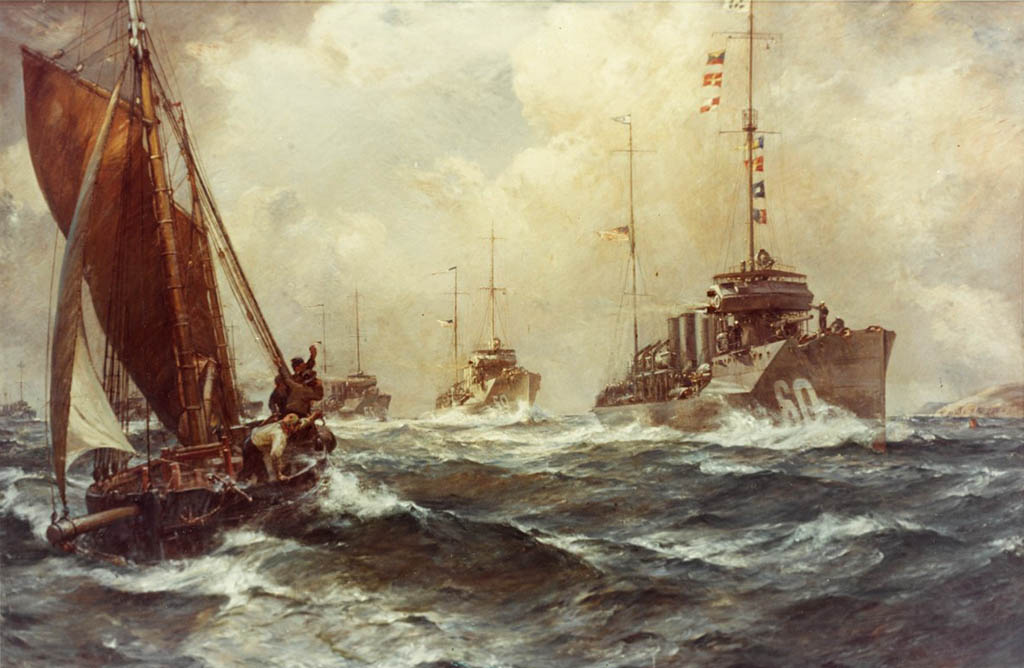
In total, the United States sent 2.8 million service personnel overseas, out of 4.7 million men and women who served in the regular U.S. forces, the National Guard, and draft units. Of those who saw action, 53,402 were killed; 63,114 deaths occurred due to diseases and other causes; and 205,000 were wounded.
Fifty months after the opening salvos in August, 1914, delegates representing the Allied Powers and Germany met in a railway carriage in the Forest of Compiègne. On November 11, 1918 the “Armistice with Germany” to end hostilities and affect the surrender of Germany, took place. The Armistice was agreed upon at 5:00 a.m. and was to go into effect at 11:00 a.m. as was written: “Cessation of hostilities by land and in the air six hours after the signing of the armistice,” which meant that the surrender took place on “the eleventh hour, of the eleventh day, of the eleventh month.”
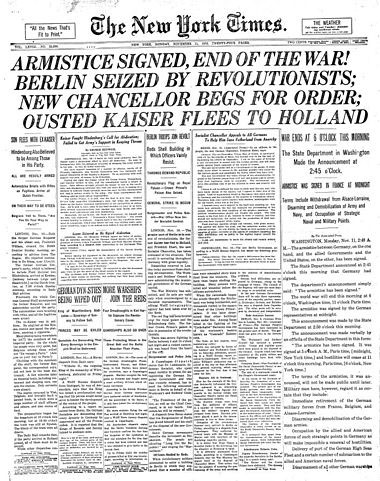
From the Treaty of Ghent to the Armistice
As we reflect on the causes and devastating casualties of The Great War – the “war to end all wars” – the success of the alliance of the United States and Great Britain during the war can be traced back to the “firm and universal peace” that has most often existed between the United States and Great Britain since 1814. One hundred years after the Armistice, both countries and much of Europe are marking this important anniversary. The United States World War One Centennial Commission has lead the way for America, marking significant moments of the U.S. participation in the war. The United Kingdom, equally, has had special events since the summer of 2014. And the countries of Europe that engaged in World War I have hosted and will host many similar commemorations.
Sunday, November 11, 2018, marks the 100th anniversary of the Armistice with Germany. As a special tribute to the millions of armed forces and civilians affected by The Great War, the United States World War One Centennial Commission, with its European counterparts and groups all across the U.S., participated in “Bells of Peace, A World War I Remembrance.”

The tolling of bells will took place at 11:00 a.m. local time, all across America and Europe, in remembrance of those who served and sacrificed. For more information, please visit the United States World War One Centennial Commission website.
[1] “The War, The Great War, The First World War,” Stuart Lee, https://ww1centenary.oucs.ox.ac.uk/memoryofwar/the-war-the-great-war-the-first-world-war/.
The Author(s)
Margherita Desy, Historian, Naval History and Heritage Command Detachment Boston
Historian, Naval History and Heritage Command
Margherita M. Desy is the Historian for USS Constitution at Naval History and Heritage Command Detachment Boston.
